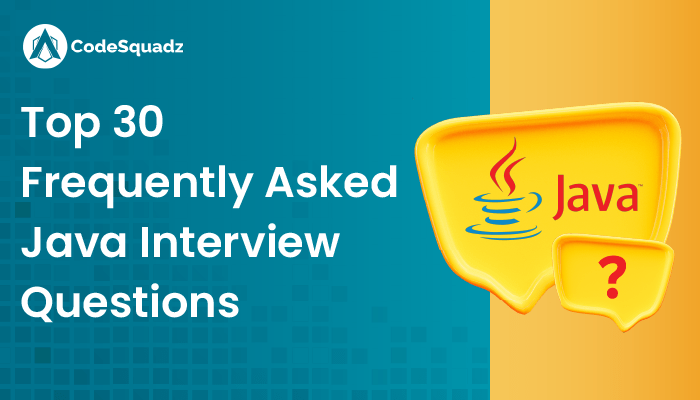Whether you are just starting your career or changing a job, you need to give a job interview. Every interview examines the knowledge base of any job aspirant before hiring anyone. An interviewer chose to ask some questions to check theoretical as well as practical knowledge.
Globally, around 10 million Java developers are available and this number is increasing continuously. The popularity of Java is increasing because it is one of the most common programming languages to develop anyone’s IT career. Java is useful as it is a high-level, object-oriented, and class-based programming language.
These interview questions bother both freshers and experienced professionals. So we are here to help you out through this article in which we have compiled 30 frequently asked Java interview questions.
30 Commonly Asked Java Interview Questions and Answers
Here are the frequently asked questions in the interview of a Java developer.
1. What is Java?
Java is a high-level and object-oriented programming language released by Sun Microsystem and built by J. Gosling in 1995. It is a fast, secure, reliable widely-used language helpful in coding applications.
Java has a virtual machine, Java Virtual Machine (JVM) that allows Java programs to run on any platform. It comes with a robust community and a comprehensive Java Class Library (JCL).
2. What are the main features of Java?
Here are the top 5 features of using the Java programming language.
- Java is easy-to-use and simple to understand without any technical complexities.
- This programming language is architecturally neutral with its “no implementation dependent” feature.
- It is a portable programming language with WORA (write once, read anywhere) feature.
- Java is platform-independent because it can work on any type of OS and device.
- Java is a robust and secure advanced programming language because it uses encryption and decryption.
3. What is the difference between JDK, JRE, and JVM?
Java Development Kit (JDK) is a software development kit (SDK) and Java Runtime Environment (JRE) permits Java programs to run. Whereas, Java Virtual Machine (JVM) is a platform-independent environment to execute bytecode.
4. What is the difference between checked and unchecked exceptions in Java?
| Checked Exceptions | Unchecked Exceptions |
|---|---|
| Need to be declared explicitly. | Don’t need to be declared explicitly. |
| Requires checking by a compiler. | Doesn’t need to be checked by a compiler. |
| Requires explicit handling using the “throw” keyword. | Doesn’t need explicit handling using the “throw” keyword. |
5. Explain the Java Memory Management system.
Java memory management is a process of object allocation and deallocation. In Java, you will find Garbage Collector is a system of searching for & identifying unused heap memory objects and removing or deleting them.
6. What are the different types of variables in Java?
Java has three variables (Local, Static, and Instance).
- Local Variable: A variable declared within a method is called a local variable. This variable is inaccessible from other methods or code blocks.
- Static or Class Variable: It is a variable declared static using the “static” keyword within a class. This variable exists only till the class is loaded in memory and the program is running.
- Instance Variable: Any variable declared inside a class but outside the method or block of code. Their existence depends on the existence of any objects they belong to.
7. What is the difference between String, StringBuilder, and StringBuffer?
In the Java programming language, String, StringBuilder, and StringBuffer differ based on mutability & thread-safe. Here, String & StringBuffer are mutable. However, StringBuilder is immutable.
The Performance of String is slow, StringBuffer’s performance is faster than String but slower than StringBuilder. Whereas, StringBuilder is the fastest one.
8. What is the difference between method overloading and method overriding?
Method overloading in Java is helpful to improve the readability of a Java program and is performed within a class. On the other hand, Method Overriding in Java is useful to achieve runtime polymorphism and occurs in 2 classes having inheritance relationships.
9. What is the significance of the “final” keyword in Java?
The final keyword in Java is helpful to restrict a user by not enabling him to modify a variable, method, or class.
Final Variable: A variable with the Final keyword can’t be modified.
Final Method: After making any method Final, you can’t override it.
Final Class: It is impossible to extend any class after finalizing it.
10. What is a static method in Java?
A Static Method in Java is a method to belong to a class (and not the instance of a class). A static method (or class method) can access static variables without using class objects.
11. Explain the concept of abstraction and encapsulation in Java.
Abstraction and Encapsulation are the features of OOPs.
Abstraction is an OOPs feature that is well-known to hide unnecessary details (and show important information only). It can resolve an issue only at the design level and focuses on the external view of class or objects.
Encapsulation is also an OOPs feature that complements abstraction which hides code and data into a single unit. It can solve any issue at the implementation level and focuses on internal work.
12. What is the difference between an interface and an abstract class?
Interface & Abstract Class are important concepts of Java and are useful to achieve abstraction. Here are the key differences between these two.
- The Interface has an abstract method. However, an Abstract Class can have abstract and non-abstract methods.
- Interface is famous for supporting multiple inheritance and an Abstract Class is popular as it doesn’t support multiple inheritance.
- The Interface has static & final variables and an Abstract Class can have final, non-final, static, & non-static variables.
- Implementation of the Interface is possible using the “implements” keyword. An Abstract Class can be implemented using the “extends” keyword.
13. What are the access modifiers in Java?
Access modifiers are keywords to control the visibility of classes, methods, and constructors. In the Java programming language, there are 4 access modifiers that are given here.
- Private: It is accessible within the same class and not from outside the class.
- Public: It can be accessed within & outside the class and within & outside the package.
- Default: Allow access only within the same package (also known as package-private access).
- Protected: Access level is within and outside the package using a child class.
14. How does exception handling work in Java?
Exception Handling is one of the robust mechanisms in Java to handle runtime errors in it. Here are the steps to define the working of exception handling in Java.
Step 1: Once an error occurs within the method of a Java programming language, it creates an object (Exception Object). It handles this object in the runtime environment.
Step 2: Here, the runtime system tries to search for an appropriate exception handler to handle the exception.
Step 3: The runtime environment searches for a call stack to handle the exception in the Java programming language.
Step 4: Finally, the exception handler catches the exception if the system searches all the methods on the call stack and is unable to find a perfect exception handler.
15. Explain the concept of multithreading in Java.
Multithreading is a programming concept in Java that is a process of executing multiple threads at once. It is mainly used in gaming, video playing, display animation, etc. It is important as it saves crucial time by performing multiple operations together.
16. What is a deadlock in Java? How can it be avoided?
Deadlock in the Java programming language is part of multithreading. Deadlock is a critical situation when 2 or more threads attempt to access the same object which is already acquired by any other thread. Indeed, it is crucial to avoid deadlock(s) in Java. However, it is possible with the unique 3 strategies that are given below.
- Recorder Deadline in Java and recover them which requires frequent checking of the available resources.
- Using locks only for the necessary members is required. Here, the unnecessary use of locks leads to a deadlock situation.
- Order your resources in Java to prevent circular wait conditions by ensuring that threads always request resources in the same order.
17. How does garbage collection work in Java?
Garbage collector in Java refers to an automatic memory management process. It finds unused objects in the memory and removes them to free up the spaces. It works in Java using these methods.
Mark and Sweep Method
This method has a common use in Java that involves two main phases: marking and sweeping. The Garbage Collector marks all objects that are still reachable and scans the entire memory & reclaims object memory that is marked as reachable.
Generational Garbage Collection
It divides the heap into multiple generations, including the Young & Old generation. Here, all newly created objects are assigned to the Young and others to the Old generation.
Minor and Major Collection
Minor or Young collection occurs when the young generation is full and promotes objects to the old generation. Major or old collections occur when old generations require them to be reclaimed.
18. What is the difference between a stack and a heap memory in Java?
For the Java programming language, it is vital to manage memory, which is automatic in Java. Java Virtual Machine (JVM) divides it into 2 parts: Heap Memory and Stack Memory.
Stack Memory: It is a physical space that is created when a thread creates. It is smaller in size and follows a LIFO, Last In First Out, method. It has less cost with hard implementation.
Heap Memory: It is created when the application starts and remains till the application runs. It is known for not following any specific order and comes in large sizes, especially when we compare it with Stack Memory. Comparatively, it has a higher cost with easy implementation.
19. Explain the concept of object-oriented programming (OOPs).
Object-oriented programming (OOPs) in Java is based on classes and objects. OOPs, encourage the reuse of objects in the same as well as other programs. Here, the data is available in the form of fields (Attributes) and code in the form of procedures (Methods).
The four pillars of OOPs are encapsulation, inheritance, polymorphism, and abstraction.
1. Encapsulation: It is one of the basic concepts of OOPs to bind the data & functions together that operate on that data within a single unit known as Class.
2. Inheritance: Inheritance is one of the key features of OOPs. It is a mechanism that empowers a class to derive properties of another class. It permits programmers to reuse the already written codes.
3. Polymorphism: Polymorphism is the ability of a class to provide several implementations of a method. It has two different types “Compile-time and Runtime polymorphism.
4. Abstraction: Abstraction is an important feature of OOPs which is simply a method of hiding information details from a user and showing only the functionality of a method to the user.
20. What is the difference between an ArrayList and a LinkedList?
Below are the key differences between ArrayList and LinkedList.
| ArrayList | LinkedList |
|---|---|
| ArrayList is internally implemented as a Dynamic Array for storing the elements. | LinkedList is implemented as a doubly-linked list to store the elements |
| The speed of manipulation with ArrayList is slow. | The speed of manipulation with LinkedList is faster when compared to ArrayList. |
| Indeed, ArrayList is better for Storing data. | LinkedList is better when it comes to the manipulation of data. |
| The default capacity is 10 for ArrayList. | There is no restriction on the capacity of LinkedList. |
21. Does Java support multiple inheritance?
No, Java programming language doesn’t support multiple inheritance to avoid creating any ambiguity like a Diamond Problem. In this problem one class can inherit the property of another class or when two or more declare a default class with the same property and name.
22. What is the purpose of the “transient” keyword in Java?
In the Java programming language, the “transient” keyword helps to avoid variable serialization. This keyword avoids the original value of an object and stores only its default value. Therefore, it plays a key role to meet security constraints by not storing private data in a file.
23. What is the difference between the “==” operator and the “equals()” method in Java?
In Java, the “==” Operator and “equals()” methods are helpful for the comparison of two objects.
However, they are completely different and their differences are:
| == | equals() |
|---|---|
| It is an operator | It is a method |
| Used for Reference Comparison | Used for Content Comparison |
| Overriding is not allowed | Overriding is allowed |
24. What are the different types of exceptions in Java?
In the Java programming language, there are 3 types of expectations are:
Checked Exceptions (also known as Compile-time Exceptions) are the exceptions checked during compile-time by the compiler. The compiler ensures that a programmer handles the exceptions, otherwise, there will be a compilation error.
Unchecked Exceptions (also known as Run-Time Exceptions) aren’t checked at the compile-time. Most of the time, an error in the programming language causes this exception and it is the direct subclass of the RuntimeException class.
User-Defined Exceptions
This type of exception occurs when any Java programmer customizes a program using a “throw keyword”. It is also a result of any error committed at the time of program execution.
25. What is the purpose of the “synchronized” keyword in Java?
The “Synchronized” Keyword in the Java programming language is helpful to control access to any shared resource in a multithreaded environment. It helps in maintaining data integrity by preventing multiple threads from modifying the shared data.
In addition, it helps in thread synchronization to ensure that modifications done by one thread within a synchronized block are visible to other threads when they acquire a lock.
26. Explain the concept of method overriding in Java.
In Java, overriding is an important feature that permits a subclass (or child class) to have a method same as declared in the parent class. It is popular for overriding in Java that serves several purposes, including Polymorphism, Specialization, Abstraction, and Code Extension. For method overriding in Java, a method should have the same name and parameter as a Parent class.
Master Java development by enrolling through our online Java course!
27. How do you handle errors in Java?
Here is an overview of how a programmer can handle errors in the Java programming language.
Try Catch-Block: It permits a programmer to pre-define a code block to be tested from the errors in Java. It happens in pairs and defines a code block to be executed.
Finally Block: It is also an available option for a programmer to use finally block after trying catch-block. The code it contains will execute even if there are no Java errors (exceptions).
Throw Exception: A programmer can also use the “throw” keyword to throw an exception explicitly. It is useful to throw a custom exception (error) in the Java programming language.
28. What is the difference between a constructor and a method in Java?
In Java, both constructors and methods are different, their key differences are:
| Constructor | Method |
|---|---|
| Used to create and initialize an object | The Method is used for the execution of certain statements. |
| It doesn’t have a return type. | It has a return type. |
| Has the same name as the class name. | The name can be anything. |
| A constructor can’t be inherited by a subclass. | A method name is the same as the name of a subclass. |
29. How can you prevent a class from being inherited in Java?
To prevent a class in Java from being inherited, the “Final” keyword is useful. It is helpful to declare a class as “Final” and always indicate that it can’t be subclassed.
30. Explain the concept of the Java Virtual Machine (JVM).
Java Virtual Machine (JVM) is a virtual machine that empowers a computer to run a Java program. It is a specification, implementation, and runtime instance. It can load, verify, and execute codes with a classloader as its subsystem. JVM is platform-independent and includes a just-in-time (JIT) compiler.
Conclusion
These are some of the most frequently asked Java interview questions to help you cover both basic as well as advanced Java concepts. These questions have answers provided by the subject matter experts. It is helpful to kick-start your career after completing our Java training. Stay tuned to get our next knowledge-rich blog on the most common Digital marketing interview questions.





